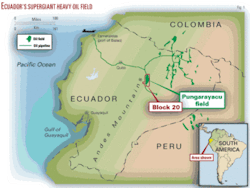Ecuador’s giant Pungarayacu to see heavy oil appraisal
Ecuador’s state-owned Petroecuador and Petroproduccion have signed a 30-year contract with Ivanhoe Energy Ecuador Inc., a subsidiary of Ivanhoe Latin America, to explore and develop Block 20 on the western edge of Ecuador’s Amazon basin.
Block 20 contains the 250-sq-mile Pungarayacu heavy oil accumulation along the Napo uplift.
Ivanhoe said the contract covers project appraisal and the development, including production and upgrading the heavy oil of the 426-sq-mile Block 20, which lies 125 miles southeast of Quito, the Ecuadoran capital.
Pungarayacu field was discovered 30 years ago. During the 1980s, Petroproduccion drilled 26 core holes in the field, which has been studied and evaluated by Petroproduccion, ARCO, and other oil companies.
According to Ivanhoe, “these third-party studies estimated that Pungarayacu contains between 4.5 billion bbl (Petroecuador-ARCO) and 7 billion bbl (Petroecuador) of oil in place.” Ultimate development cost will range to several billion dollars.
The Cretaceous Hollin sandstone, one of the principal producing formations in Ecuador’s Amazon basin, is the pay zone at Pungarayacu. It is 250 ft to more than 300 ft thick and is topped from surface to deeper than 1,500 ft.
The firm said confirmation of these resources “would make the Pungarayacu field the largest accumulation of heavy oil in Ecuador and one of the largest in Latin America.”
Ivanhoe also believes there is potential for deeper exploration for lighter oil.
Ivanhoe said, “This deeper zone in the Pungarayacu field has not yet been drilled with exploration wells, but the field lies on a regional arch that could focus migrating oil into this area.”
Production plans
According to project plans, oil production will begin with 30,000 b/d, eventually rising to 120,000 b/d of 9-14° gravity oil.
Ivanhoe plans to use its heavy-to-light (HTL) technology to upgrade the heavy crude into grades of 23° gravity crude. The viscosity-reducing technology is proprietary and patented but unproven at commercial scale in the oil industry. Modules as small as 10,000 b/d are being designed in San Antonio, the company said.
“We look forward to demonstrating the substantial advantages of our HTL process, which include enhanced efficiency, significant environmental benefits, and the economic production of previously stranded petroleum resources,” said David Martin, a seasoned Latin American geologist and executive chairman and chief executive officer of Ivanhoe Latin America.
Investment requirements are estimated to be $20 million during the first year of the contract and a total of approximately $110 million for the first 3 years of appraisal.
To recover its investments, costs and expenses, and to provide for a profit, Ivanhoe will receive from Petroproduccion a payment of $37/bbl of oil produced and delivered to Petroproduccion.
The payment will be indexed quarterly for inflation, starting from the contract date, using the weighted average of a basket of three US government-published producer price indexes relating to steel products, refinery products, and upstream oil and gas equipment.
Ivanhoe Energy Ecuador may elect to receive its payment in oil, based on market prices, Ivanhoe said.
The company said it is in detailed discussions about Pungarayacu development partnerships with international oil companies, including Asian companies.
Accruals from the block
Petroecuador said in early October that it expects to obtain more than $40 billion in revenue from Pungarayacu field. That followed a statement in August by Petroecuador Pres. Luis Jaramillo who said that Ivanhoe would start producing about 108,000 b/d of heavy oil at the Pungarayacu field by May 2009.
Such a time line seems highly optimistic, however. Ivanhoe said no field work will begin until after 6 months of environmental studies. The succeeding 3-year appraisal phase would involve seismic surveys, drilling appraisal and production wells, and conducting steam injection tests of the various sands.
Nevertheless, a greatly underutilized 400,000 b/d oil pipeline to the Pacific Coast port of Esmeraldas crosses Block 20, Ivanhoe noted.
New wells are required because the 26 uncased core holes have been plugged.
White et al. wrote in AAPG Memoir 62 that cumulative production from Ecuador’s Oriente from 1972 through 1992 was 1.7 billion bbl from Hollin and 1.17 billion bbl from the overlying Cretaceous Napo formation. They estimated remaining recovery in the province at 2 billion bbl in the succeeding 20 years, mainly from existing fields and developments already under way in the early 1990s.
Exploration on the block outside Pungarayacu might raise its estimate of oil in place to 15-20 billion bbl, said Robert Friedland, executive chairman of Ivanhoe.
In 2007, Ecuador rejoined the Organization of the Petroleum Exporting Countries and has an assigned production quota of 520,000 b/d.
The country had a total output of about 511,000 b/d in 2007, including production by Petroecuador and private oil companies operating in the country (OGJ Online, Aug. 22, 2008).

